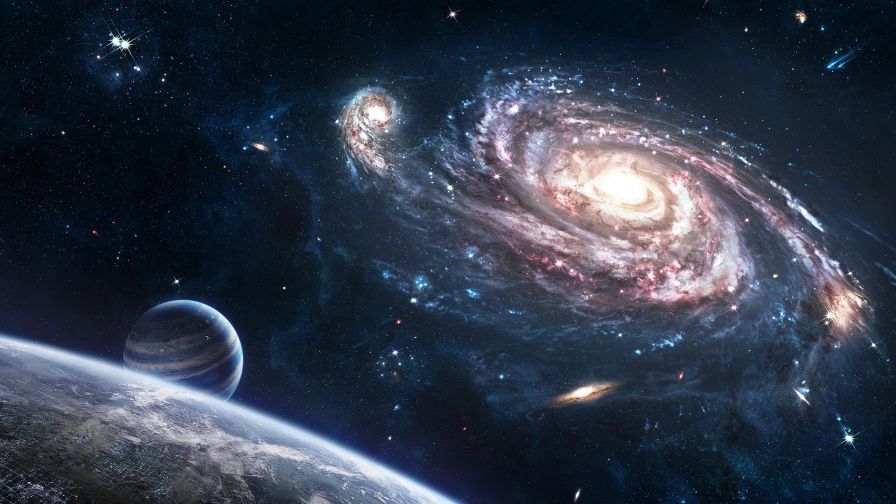Astrophysicists will look for signs of life in the atmospheres of faraway planets, and NASA’s James Webb Space Telescope has shown that this is possible. The necessary components for life are dispersed across the universe. Despite the fact that Earth is the only known location in the cosmos containing life, discovering life beyond our planet is a key objective of contemporary astronomy and planetary research.
We are two scientists who research extrasolar planets and astrobiology. Soon, scientists like us will be able to determine the chemical composition of the atmospheres of planets orbiting other stars, thanks in great part to powerful next-generation observatories like James Webb. On one or more of these exoplanets, a chemical signal of life is hoped to be detected.
Liquid water may support life in our solar system, such as in the oceans of Jupiter’s moon Europa or the subterranean aquifers of Mars. Searching for life in these locations is extremely difficult due to their inaccessibility and the need to send a probe to gather and return tangible samples. Many astronomers believe that life exists on planets orbiting other stars, and it is feasible that this is where extraterrestrial life may be discovered for the first time.
Theoretical calculations suggest that the Milky Way galaxy contains about 300 million potentially habitable planets, including several Earth-sized planets located within 30 light-years of Earth. These planets would be humanity’s galactic neighbors. Using indirect methods that analyze how a planet influences its host star, astronomers have discovered over 5,000 exoplanets to date, including hundreds of potentially habitable worlds. While these observations can offer astronomers with basic information about an exoplanet’s mass and size, they yield little else.
Astrobiologists will examine starlight that has interacted with a planet’s surface or atmosphere in order to identify life on a distant planet. If the atmosphere or surface been altered by life, the light may contain a biosignature, or a clue.
Earth’s atmosphere lacked oxygen for the first half of its existence, despite the presence of basic, single-celled life. During this early period, the Earth’s biosignature was very feeble. This dramatically altered 2.4 billion years ago, when a new family of algae arose. The algae utilized a photosynthetic method that generates free oxygen – oxygen that is not chemically bound to any other element. Since then, the oxygen-rich atmosphere of Earth has imprinted a strong and easily visible biosignature on light passing through it.
When light reflects off the surface of a substance or passes through a gas, some wavelengths are more likely to remain trapped in the surface of the material or gas. Why things have the colors they have has everything to do with the wavelengths of light that are absorbed selectively. Green tint in leaves is due in part to chlorophyll’s ability to efficiently absorb red and blue light. When light hits a leaf, it absorbs most of the red and blue wavelengths, leaving mostly green light to reflect back to your eyes.
The pattern of light loss is governed by the nature of the substance with which the light interacts. Consequently, astronomers can determine the composition of an exoplanet’s atmosphere or surface by essentially measuring the exact color of light emitted by a planet.
Because these gases leave extremely precise traces in light, this approach can be used to detect the existence of life-sustaining air gases such as oxygen and methane. It could also be used to detect unusual hues on a planet’s surface. On Earth, chlorophyll and other pigments used for photosynthesis by plants and algae absorb specific wavelengths of light. These pigments emit distinctive colors that can be recognized by an infrared camera with high sensitivity. If you observed this color reflected off the surface of a faraway planet, it could indicate the presence of chlorophyll.
To detect these slight variations in the light emitted by a potentially habitable exoplanet, a very powerful telescope is required. The only observatory now capable of such an accomplishment is the upcoming James Webb Space Telescope. In July 2022, Webb took a spectrum measurement of the planetary system exoplanet WASP-96b, which had only recently begun scientific operations. Even if the spectrum revealed the presence of water and clouds, it seems improbable that a planet as massive and hot as WASP-96b could support life. These preliminary findings, however, show that James Webb can detect minute chemical signatures in the light of exoplanets. Webb will soon point its mirrors at TRAPPIST-1e, an Earth-sized planet only 39 light-years away that may be inhabited.
Webb searches for biosignatures by monitoring planets as they pass in front of their home stars and by capturing filtered starlight. Webb wasn’t designed to find life, so it can only explore a few potentially livable worlds. Additionally, it can only detect changes in the quantities of carbon dioxide, methane, and water vapor in the atmosphere. Certain combinations of these gasses may indicate the presence of life, but Webb is unable to detect the presence of unbonded oxygen, the strongest evidence for life.
There are proposals for future, even more powerful space telescopes to block the brilliant light of a planet’s host star in order to see the starlight reflected off the planet. This concept is analogous to using your hand to block sunlight to better see distant objects. To accomplish this, future space telescopes may employ either small, interior masks or massive, exterior spacecraft resembling umbrellas. Once the starlight is obstructed, it becomes much simpler to observe the planet’s reflected light.
Three of the largest ground-based telescopes ever built are now under construction; the European Extremely Large Telescope, the Thirty Meter Telescope, and the Giant Magellan Telescope. These telescopes may be able to peer into the atmospheres of neighbouring planets in search of oxygen despite the fact that Earth’s atmosphere bends starlight.


